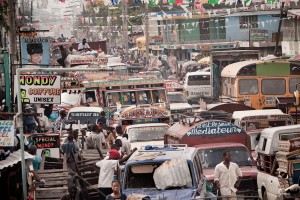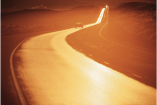Port au Prince: Bad roads, worse driving,appalling arrogant UN vehicles

This is not a particularly recent photograph but traffic-clogged Port au Prince remains much the same
Yesterday, we drove to the supermarket near our house and unusually, were back home in just 25 minutes flat. (That included whipping in and out of the supermarket in a mere five minutes). It was a strange and glorious red-letter day. Let me explain.
Belmart Supermarche, Tabarre, in the Haitian capital, is a 10-minute walk from where we live. But it’s rarely possible to do it on foot, there being no pavements and dangerously free-form driving. A combination of Port au Prince’s murderous traffic and bad (barely there) roads, means a 10-minute walk can easily stretch into a 50-minute journey. Or longer.
Sudden traffic jams (“blokus”, as they’re evocatively called in kreyol) are common on the streets of Port au Prince. They are generally inexplicable and stay unexplained. One minute, the road is clear; the next it boasts an untidy blockade of cars, motorcycles, trucks and tap-taps, uselessly stranded and ceaselessly manouevring, stirring up ever-greater clouds of dust.
One of the problems is those who drive on Haitian roads. They seem to pay scant heed to notions of civic courtesy and the common-sense rules that keep everyone safe. And then there’s the ubiquitous white United Nations’ 4-wheel-drive vehicles. They’re everywhere (as is MINUSTAH, the French acronym for the UN peacekeeping force here) and generally, they’re simply appalling – arrogant, unrestrained, dangerous to other road-users.
Even so, the roads (or lack of) are a huge issue as Haiti struggles to market itself, of all things, as a tourist destination. (Here is an NYT piece referring to the problem, even as the Best Western hotel opened.) The beauteous tourism minister, Stephanie Villedrouin, is acutely conscious of this, as well she might be. Early last year, after the first batch of Transat tourists flew into Haiti, she acknowledged the doleful effect of Port au Prince’s bad traffic and bracingly suggested it could be managed by working out the right times of day for visitors to tour local attractions (such as the Rhum Barbancourt factory). She wasn’t wrong. Traffic patterns can be arranged. Quiet times can be found. But, at some point, the roads need to be fixed. Or built from scratch. And the UN 4WD must leave.


